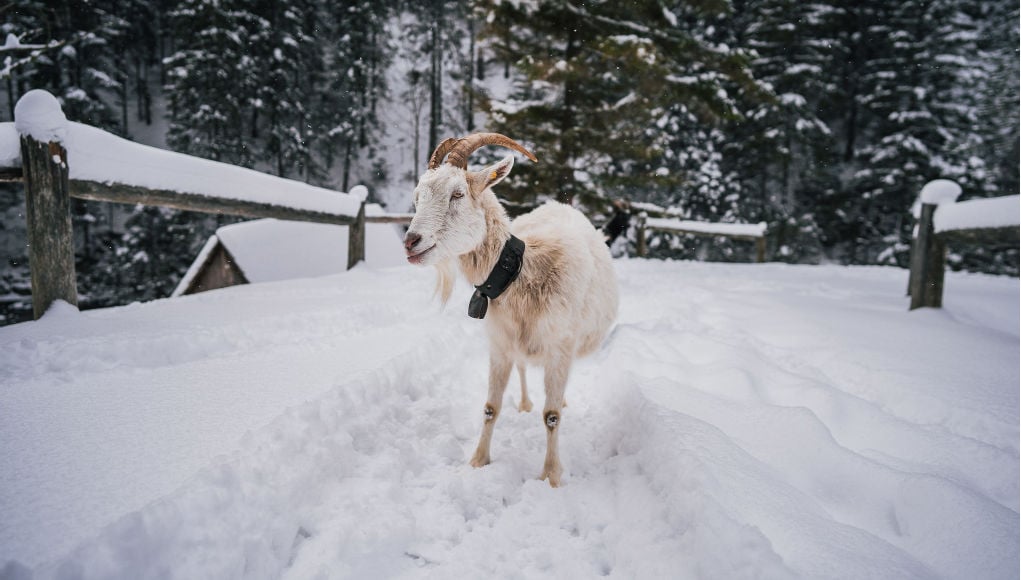When choosing any livestock animal, the overwhelming options, varying opinions, and information overload can be intimidating.
When choosing the right goat for your homestead (especially if that homestead is buried in snow half the year), there are a few factors to consider.
The most common purpose for keeping goats is milk, followed by meat, mohair and cashmere. Most goats are, at the very least, dual-purpose.
However, getting these resources becomes a challenge when the winter season comes along. That’s why it’s important to pick the best goat breeds for winter if your area is experiencing more of this climate.
In this article, we will discuss the best goat breeds for winter and what are the best practices to take care of them when that season arrives.
Top 4 Goat Breeds for Winter
As mentioned above, goats are raised for milk, meat, or both. In this case, we have compiled a list of goats that thrives in snow and what their abilities are:
Milking Breeds
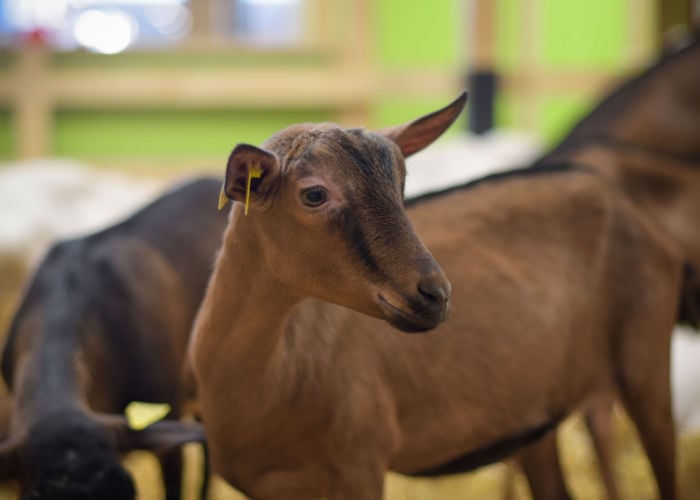
Alpine
Originating in the French Alps, this mountain goat boasts winter adaptability. They’re best known for their great milking lines.
Their dense coats on slender bodies and long legs make for a goat who can easily traverse the snow drifts their earlier ancestors did.
TheAlpine goat可能是理想的如果你考虑一个乳制品品种you have to bring through winter.
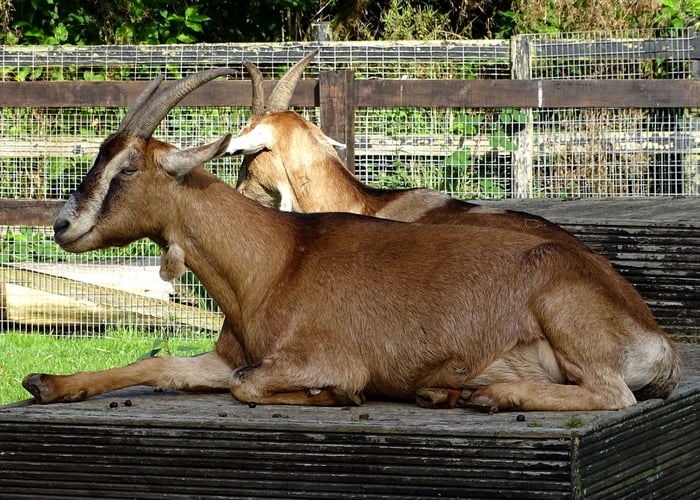
Toggenburg
The Toggenburg goat stems from wintery beginnings. The Toggenburg Valley in Europe is the home of the Toggenburg goat and welcomes a fair amount of snow for most of the year.
It is another milking goat with long, lean bodies on spindly legs that reach above the snow.This goat is well known as an impressive winter milking breed.
Pairing a dairy breed with a meat-type goat could provide you with a beautiful milk and meat option.
Meat Goats
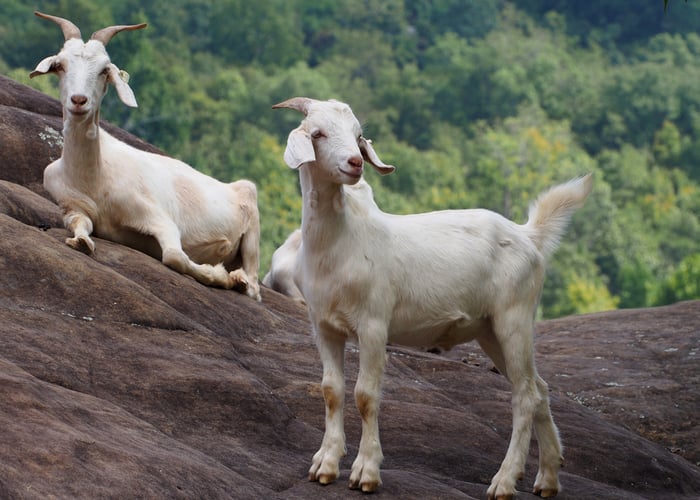
Kiko
The Kiko goat hails from New Zealand but quickly made traction when entering the United States in 1992 and Canada in 1998 as a meat goat with past dairy lines.
This makes an excellent pasture goat with a closely cropped coat, tall stature and thick body.
The Kiko overwinters, as well as any goat can, assuming it has a place to escape the harshest elements if need be.
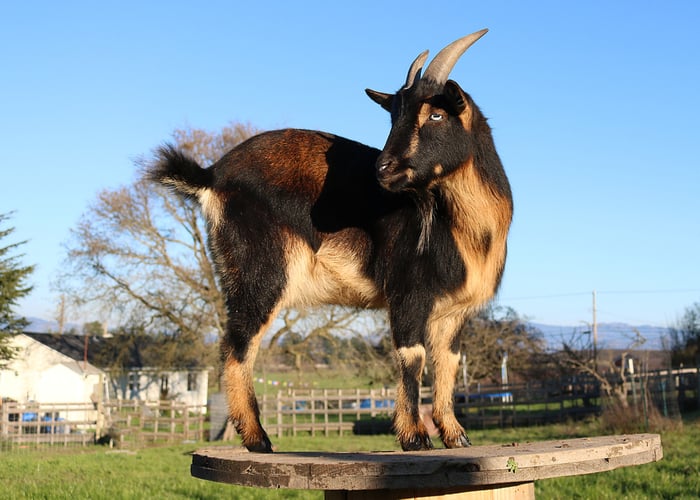
Nigerian Dwarf
I know what you’re thinking—how can a compact goat with partial origins in West Africa adapt to a cold, snowy climate?
This breed, developed in the United States, takes the winter in stride with their dense bodies that grow a cashmere undercoat that puffs out to encompass the goat and retain body heat.
这适应寒冷给尼日利亚Dwarf a fuzzy appearance in the winter. They are used primarily for milk.
TheNigerian Dwarfis not necessarily a front runner for meat production due to their size, but it is well known that the extra wethers fill a freezer if mixed with a larger-bodied breed.
4 Ways To Winter-Proof Any Goat Breed
A goat in cold weather, as in any weather, may surprise you.
On the coldest, windiest, snow-filled day, you may look out the window to see a few goats happily chewing their cud amidst the storm before moseying back to the barn. What gives?
You’d be surprised that most of the goat breeds are cold-hardy. Some could even withstand the cool temperature as long as your goats have a decent shelter.
Aside from choosing the goat breeds for winter above, you can have any goat to add to your homestead and help them get through the winter instead.
By following these simple yet effective ways to winter-proof your goats, you’ll have happy and healthy animals by the end of the cold season!
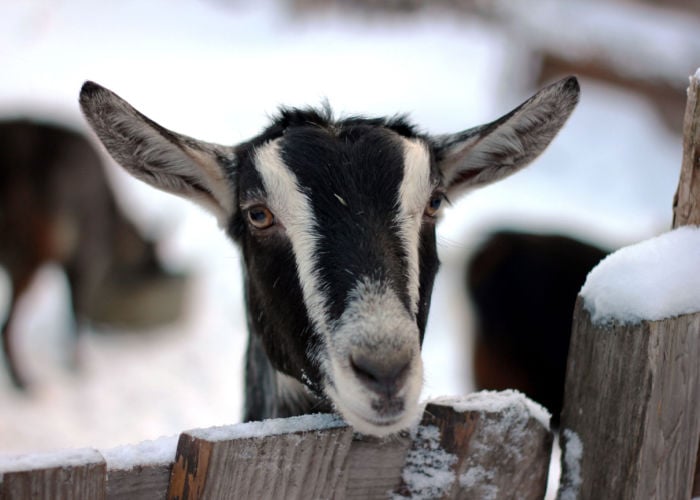
Shelter
Like most livestock animals, goats will need helpful humans to survive and thrive far removed from their mountain or desert ancestors.
Shelter for goats in the winter plays the most critical role in keeping your goats comfortable.
A three-sided shelter facing out of the wind will ensure your goats stay dry and warm if a fully enclosed barn is not accessible.
Straw and/or shavings can be added to the shelter as insulation between huddled bodies.
A goat, especially one with 24/7 access to the outdoors, will slowly grow their winter coat as the cooler weather settles in.
Therefore, they can handle colder temperatures like humans when we sport winter jackets.
While they don’t particularly want to be outside in a blizzard all season long, adult goats weather the storm better than young kids (especially newborns).
If you know your doe is nearing her kidding date, access to a shelter with warm, dry bedding is essential. After giving birth, a doe has difficulty regulating her body temperature.
Therefore, birthing in these elements could cause her to freeze. Using her energy and keeping warm could prevent the doe from properly drying her kids, who would suffer the same fate.
Human Intervention
Some farmers downright refuse to kid during the winter months. The choice is usually due to the unpredictable weather.
It’s somehow nature’s law that each doe must pick the coldest night of the year to deliver three gangly newborns.
During the kidding season, I find it best practice to leave the expecting doe in a familiar place when kidding takes place.
For example, I prefer a doe to kid in the barn that has 24/7 access instead of a shop near the house which means a lot of lugging equipment.
We attend every winter birth with towels (a lot of towels), lukewarm water (for necessary cleaning), a heating pad, a heat lamp and a lot of patience.
If the kid is born and, for any reason, the mom cannot dry right away, we will ensure the baby’s body temperature stays up by patting dry with a towel, and the mom spends less time mothering to conserve energy.
If the newborn is subjected to unrelenting cold, a coat or sweater could be used after the pair has bonded. A heating pad (with supervision) can warm a shivering kid if the doe is still labouring.
Much like adult goats, guaranteeing a newborn’s survival enables them to stay warm and dry. Warm water is brought to the new mother as it is necessary for milk production and replenishing the mother’s fluids.
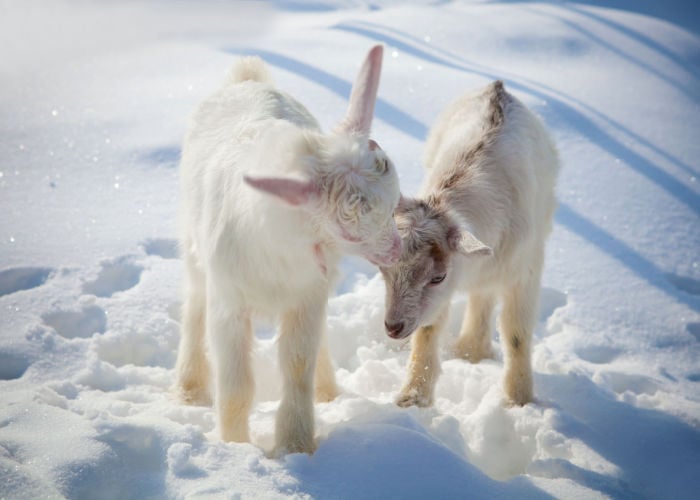
Nutrition And Care
During the winter season, adult goats must have access to high-quality hay, as browsing is nearly nonexistent.
They require something in their rumen, as it generates heat from within. Therefore, hay nets or slow feeders can be useful for hourly access to feed.Clean, fresh, cool water aids in healthy digestion as well.
By providing access to a salt lick, free-feed mineral bucket ormineral tubs, each goat maintains healthy vitamin levels while unable to forage.
A goat battling a heavy parasite load will struggle through winter as it fights the worm for nutrients and a stable body condition.
Ensuring your herd is protected against the inside invaders will make for a successful winter.
Safety In Numbers
As you may know, goats are herd animals. They thrive in large herds for safety, knowledge, and social structure.
They benefit from extra eyes watching for unwelcome predators, and many bodies also create a cross-herd-thermal blanket.
We house sheep with goats in the winter, and their dense, coarse hair, accompanied by a large body, throws plenty of heat to warm our barn and each other.
Best Goat Breeds for Winter: Conclusion
If you are looking for the best goat breeds for winter, the four cold-hardy choices we mentioned are genetically the best place to start.
However, a goat—be it an Alpine, a Lamancha or an Angora—will thrive in the harshest winters.
Still, it pays to take extra precautions to care for goats during the winter. With the help of our winter guide, you can have healthy goats as soon as Spring comes.
As an extra, we sometimes supply heated mash, close barn doors, throw extra bedding and grant access to additional feed to carry each goat through winter.
Winter may be a challenging season to deal with when raising goats. But it doesn’t have to be difficult for either you or your goats.
With the goat breeds for winter and the best practices mentioned above, your goats will surely thrive in the cold season without you worrying all the time!
